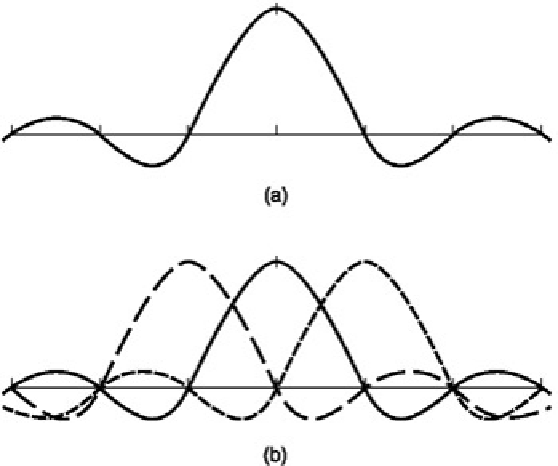Information Technology Reference
In-Depth Information
A serial data waveform basically contains a train of rectangular pulses. The transform of a rectangle is the function
sin
x
/
x
and so the baseband pulse train has a sin
x
/
x
spectrum. When this waveform is used to modulate a carrier
the result is a symmetrical sin
x
/
x
spectrum centred on the carrier frequency.
Figure 7.11
(a) shows that nulls in the
spectrum appear spaced at multiples of the bit rate away from the carrier.
Further carriers can be placed at spacings such that each is centred at the nulls of the others as is shown in
Figure
7.11
(b). The distance between the carriers is equal to 90° or one quadrant of sin
x
. Owing to the quadrant spacing,
these carriers are mutually orthogonal, hence the term orthogonal frequency division. A large number of such
carriers (in practice several thousand) will be interleaved to produce an overall spectrum which is almost
rectangular and which fills the available transmission channel.
Figure 7.11:
In OFDM the carrier spacing is critical, but when correct the carriers become independent and most
efficient use is made of the spectrum. (a) Spectrum of bitstream has regular nulls. (b) Peak of one carrier occurs at
null of another.
When guard intervals are used, the carrier returns to an unmodulated state between bits for a period which is
greater than the period of the reflections. Then the reflections from one transmitted bit decay during the guard
interval before the next bit is transmitted. The use of guard intervals reduces the bit rate of the carrier because for
some of the time it is radiating carrier, not data. A typical reduction is to around 80 per cent of the capacity without
guard intervals.
This capacity reduction does, however, improve the error statistics dramatically, such that much less redundancy is
required in the error- correction system. Thus the effective transmission rate is improved. The use of guard
intervals also moves more energy from the sidebands back to the carrier. The frequency spectrum of a set of
carriers is no longer perfectly flat but contains a small peak at the centre of each carrier.
The ability to work in the presence of multipath cancellation is one of the great strengths of OFDM. In DVB, more
than 2000 carriers are used in single transmitter systems. Provided there is exact synchronism, several transmitters
can radiate exactly the same signal so that a single-frequency network can be created throughout a whole country.
SFNs require a variation on OFDM which uses over 8000 carriers.
With OFDM, directional antennae are not needed and, given sufficient field strength, mobile reception is perfectly
feasible. Of course, directional antennae may still be used to boost the received signal outside of normal service
areas or to enable the use of low-powered transmitters.
An OFDM receiver must perform fast Fourier transforms (FFTs) on the whole band at the symbol rate of one of the
carriers. The amplitude and/ or phase of the carrier at a given frequency effectively reflects the state of the
transmitted symbol at that time slot and so the FFT partially demodulates as well.
In order to assist with tuning in, the OFDM spectrum contains pilot signals. These are individual carriers which are
transmitted with slightly more power than the remainder. The pilot carriers are spaced apart through the whole
channel at agreed frequencies which form part of the transmission standard. Practical reception conditions,
including multi- path reception, will cause a significant variation in the received spectrum and some equalization will
be needed.
Figure 7.12
shows what the possible spectrum looks like in the presence of a powerful reflection. The
signal has almost been cancelled at certain frequencies. However, the FFT performed in the receiver is effectively
a spectral analysis of the signal and so the receiver computes for free the received spectrum. As in a flat spectrum
the peak magnitude of all the coefficients would be the same (apart from the pilots), equalization is easily
performed by multiplying the coefficients by suitable constants until this characteristic is obtained.

